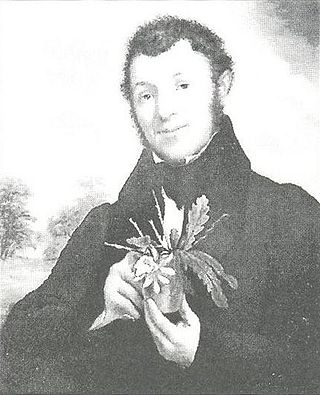Лучшие вопросы
Таймлайн
Чат
Перспективы
Хэуорт, Адриан Харди
английский ботаник и энтомолог Из Википедии, свободной энциклопедии
Remove ads
Адриан Харди Хэуорт (англ. Adrian Hardy Haworth; 19 апреля 1767[1], Кингстон-апон-Халл, Йоркшир и Хамбер[2] — 24 августа 1833[1], Челси, Большой Лондон[2]) — английский ботаник и энтомолог.
Remove ads
Биография
Адриан Харди Хэуорт родился в городе Кингстон-апон-Халл 19 апреля 1767 года. Внёс значительный вклад в ботанику и энтомологию, описав множество видов растений и насекомых. В 1792 году женился на Элизе Сидни Камбри (1768–1803), у них было четверо детей. После смерти первой жены еще дважды женился и имел детей от каждого из этих браков. В 1798 вступил в члены Линнеевского общества. Умер от холеры в Челси 24 августа 1833 года[3].
Remove ads
Научная деятельность
Адриан Харди Хэуорт специализировался на семенных растениях[4]. Активно занимался энтомологией. Результаты своих энтомологических сборов обобщил в обширной сводке Lepidoptera Britannica (1803–1828), которая стала первой крупной монографией по чешуекрылым Великобритании[3].
Публикации
- Observations on the genus Mesembryanthemum. Лондон 1794—1795[5].
- Miscellanea naturalia, sive dissertationes variæ ad historiam naturalem spectantes. J. Taylor, Лондон 1803[6].
- Lepidoptera Britannica; sistens digestionem novam insectorum Lepidopterorum quæ in Magna Britannia reperiuntur, … J. Murray, London 1803—1828[7].
- Synopsis plantarum succulentarum cum descriptionibus synonymis locis, observationibus anglicanis culturaque. R. Taylor, Лондон 1812[8]
- Supplementum Plantarum Succulentarum: Sistens Plantas Novas Vel Nuper Introductas Sive Omissas In: Synopsis Plantarum Succulentarum Cum Observationibus Variis Anglicanis. J. Harding, Лондон 1819[9].
- Saxifragëarum enumeratio. Accedunt revisiones plantarum succulentarum. Wood, Лондон 1821[10].
- A new Arrangement of the Genus Aloe, with a chronological Sketch of the progressive Knowledge of that Genus, and of other succulent Genera. In: Transactions of the Linnean Society of London. Band 7, Nummer 1, Лондон 1804, S. 1—28.
- Plantae rarae Succulentae; a Description of some rare Succulent Plants. In: Philosophical Magazine. Band 62, 1823, S. 380—382[11].
- An Account of a new Genus of Narcisseae, allied to the Genus Ajax of Salisburg. In: Philosophical Magazine. Band 62, 1823, S. 440—441[12].
- Descriptions of some new Cacti and Mammillariae, recently brought from Mexico by Mr. Bullock of the Egyptian Hall, Piccadilly; and now preserved, with many other very rare Plants in the Nursery of Mr. Tate, in Sloanestreet. In: Philosophical Magazine. Band 63, 1824, S. 40—46[13].
- Observations on the Mesembryanthema barbata. In: Philosophical Magazine. Band 64, 1824, S. 61—62[14].
- An Account of the Mesembryanthema ringentia. In: Philosophical Magazine. Band 64, 1824, S. 109—111[15].
- Decas novarum Plantarum Succulentarum. In: Philosophical Magazine. Band 64, 1824, S. 184—191[16].
- Decas secunda novarum Plantarum Succulentarum. In: Philosophical Magazine. Band 64, 1824, S. 298—302[17].
- Decas tertia novarum Plantarum Succulentarum. In: Philosophical Magazine. Band 64, 1824, S. 423—428[18].
- A new Binary Arrangement of the Brachyurous Crustacea. In: Philosophical Magazine. Band 65, 1825, S. 105—106, S. 183—184[19].
- A new Binary Arrangement of the Class Amphibia. In: Philosophical Magazine. Band 65, 1825, S. 372—373[20].
- Observations on the dichotomous Distribution of Animals: together with a Binary Arrangement of the Natural Order Saxifrageae. In: Philosophical Magazine. Band 65, 1825, S. 428—430[21].
- Decas quarta novarum Plantarum Succulentarum. In: Philosophical Magazine. Band 66, 1825, S. 27—33[22].
- Further Remarks on the Dichotomous Distribution of nature: together with a Binary Arrangement and Description of the Genus Sedum. In: Philosophical Magazine. Band 66, 1825, S. 172—178[23].
- Decas quinta novarum Plantarum Succulentarum. In: Philosophical Magazine. Band 66, 1825, S. 279—283[24].
- Decas sexta novarum Plantarum Succulentarum In: Philosophical Magazine. Band 68, 1826, S. 125—132.
- Decas septima novarum Plantarum Succulentarum In: Philosophical Magazine. Band 68, 1826, S. 328—331.
- Description of New Succulent Plants. (Decas octava novarum Plantarum Succulentarum). In: Philosophical Magazine. Band 1, 1827, S. 120—126[25].
- Description of New Succulent Plants. (Decas nona novarum Plantarum Succulentarum). In: Philosophical Magazine. Band 1, 1827, S. 271—276[26].
- Description of New Succulent Plants. (Decas decima novarum Plantarum Succulentarum). In: Philosophical Magazine. Band 2, 1827, S. 344—361[27].
- Description of New Succulent Plants. (Decas undecima novarum Plantarum Succulentarum). In: Philosophical Magazine. Band 3, 1828, S. 183—188[28].
- New Account of the Genus Echeveria. In: Philosophical Magazine. Band 4, 1828, S. 261—264[29].
- Description of the Subgenus Epiphyllum. In: Philosophical Magazine. Band 6, 1829, S. 107—110[30].
- New Account of the genus Kalanchöe. In: Philosophical Magazine. Band 6, 1829, S. 301—305[31].
- Description of New Succulent Plants of the Natural Order of Cacteae. (Decas duodecima novarum Plantarum Succulentarum). In: Philosophical Magazine. Band 7, 1830, S. 106—118[32].
- A Botanical Description of Hermione Cypri. In: Philosophical Magazine. Band 9, 1831, S. 183—185[33].
- Decas tridecima Novarum Plantarum Succulentarum. In: Philosophical Magazine. Band 10, 1831, S. 414—424[34].
Remove ads
Примечания
Литература
Ссылки
Wikiwand - on
Seamless Wikipedia browsing. On steroids.
Remove ads


